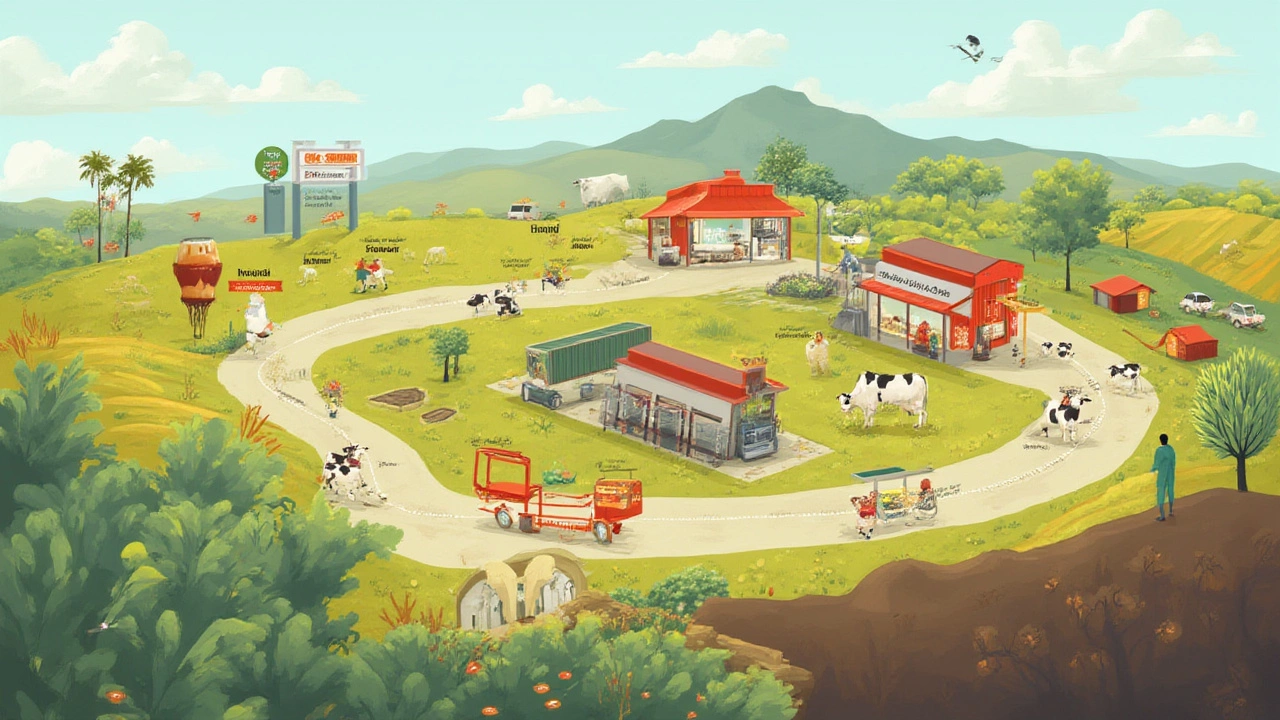20 Jul 2025
- 0 Comments
Have you noticed how buying paneer at your local market almost feels like a mini luxury now? Even a small pack can dent your grocery budget faster than a week’s worth of Greek yogurt. In Sydney and most Australian cities, paneer—a humble, unaged Indian cheese—is priced on par with those fancy European imports. Yet, paneer’s just curdled milk squished into cubes; so why’s it so dear? It’s the cheese puzzle nobody warned us about, especially for anyone craving authentic Indian dishes without breaking the bank.
So, what’s driving this price tag? On the surface, paneer looks straightforward: only milk, lemon juice or vinegar, and a bit of patience. Yet, the cost is anything but simple. From the farm all the way to your kitchen, there’s a perfect storm of factors—from sky-high milk prices in Australia to labor rules, import markups, and even trends in eating habits. Paneer production, distribution, and the sheer popularity among vegetarian and Indian food lovers—each step cranks up the price. And if you’ve tried making it at home, the price of milk alone can be shocking!
The Real Cost of Making Paneer in Australia
If you dig deeper, you’ll quickly find that paneer cheese starts life as plain full-cream milk. Now, milk in Australia is more expensive than you might expect. A litre in 2025 averages about $2.50 for branded options, and sometimes even more depending on how ‘ethical’ you want your dairy. In Sydney, the 2024-2025 Dairy Australia report noted the wholesale price of milk rose almost 14% year-over-year. Why? Australia’s dairy farms feel the pinch from drought, feed shortages, energy costs, and strict animal welfare standards. Good for cows, pricey for us.
Now, consider what it takes to actually make paneer. Making just 250 grams of paneer soaks up at least 1.5 to 2 litres of milk. Factor in gas or electricity, plus time, and you start to realise: it’s not as cost-efficient as it looks. Commercial makers face even higher costs. Sydney’s cheese factories must stick to food safety protocols that add extra labor and equipment. Everything from the temperature-controlled storage, toxins testing, hands-on processing, to regulatory paperwork drives up overhead. Add wages—Australia’s minimum hourly wage in 2025 climbs above $24, way more than cheese makers elsewhere. There’s no shortcut here.
Another issue is yield. Paneer isn’t like cheddar or feta where you get a big block from a little milk. With paneer, water separates out as whey, so a ton of liquid turns into a modest slab of cheese. Waste disposal is another cost. Whey can’t just be poured down the drain; strict Aussie environmental rules require safe management. Smaller companies, often serving the Indian community, have little economy of scale to lean on, so every dollar in cost gets baked into the price you see on the shelf.
| Milk Needed (L) | Paneer Produced (g) | Average Retail Price (AUD) |
|---|---|---|
| 2 | 250 | $8.00 - $13.00 |
| 4 | 500 | $14.50 - $22.00 |
A quick glance at this table says it all—paneer is seriously labor and resource-heavy for its size. And right now, people buy more ready-made than they make it at home, so demand stays strong while supply gets squeezed from every corner.

Import Woes, Market Gaps, and Who’s Actually Buying Paneer
So maybe you’re thinking, ‘Fine, just buy imported paneer! India must be shipping bucketloads, right?’ Well, not really. Australia’s biosecurity is strict. Cheese from other countries, especially fresh soft cheeses, jumps through more hoops than a circus performer. Authorities want to stop bacteria, disease, and ensure labeling’s accurate. That means every batch gets tested, paperwork checked, and this all adds cost and delay. Even after that, shipping’s far from cheap. A freight delay or fuel price hike in Singapore or the Red Sea, and Australian store owners eat the cost—or pass it to us.
In 2024, only a handful of brands (like Amul, Nanak, and Gopi) regularly landed paneer on Sydney grocery shelves. Supplies are patchy. If a shipment’s delayed or fails a test, shelves stay empty and local makers get swamped with last-minute bulk orders. That’s why prices swing so much store-to-store or month-to-month, especially during Diwali or when the cricket’s on.
The real clincher is who’s buying. Twenty years ago, paneer hardly lined Aussie supermarket coolers. But now, with over 800,000 people of Indian origin living in Australia, Indian cuisine is mainstream—curries and veggie kebabs turn up everywhere from Bondi cafes to school canteens. So the market’s grown in leaps, but supply chains haven’t kept up. Meanwhile, more Aussies explore vegetarian eating or flexitarian diets, and everyone’s after ‘clean label’ protein. You can see why even Coles paneer, a basic house-brand pack, goes for $8–$10 for just 200g. Specialty or organic ones tip past $20 for a half kilo in gourmet delis. Not exactly pocket change for weekday meals.
Normally, cheese has competition: cheddar, feta, and even vegan options. But for Indian food fans, only paneer gives that soft, non-melting, creamy bite that holds up in a spicy curry. Tofu won’t cut it for a good palak paneer. So, stores know you’ll pay, and prices stay stubbornly high. Outside big cities, most paneer is a specialty product. Choices drop, and freight costs per kilo go up, leading to price tags from another planet at rural grocers.
Here’s a quick breakdown of factors behind paneer’s unique market:
- Strict food safety and health certifications for imports
- Volatile international freight rates
- High demand spikes from local Indian/Australian families, restaurants, and takeaways
- Limited refrigeration in rural stores (so more wastage)
- Paneer’s short shelf life—can’t sit for weeks unsold
All this adds up to a product that looks simple in the recipe—yet isn’t simple at all by the time it hits your plate.

How to Save on Paneer and Smart Tips for Cheese Lovers
Don’t let sticker shock spoil your love of curries and tikkas. There are ways you can stretch or outsmart the expensive paneer price tag. First, if you live near a market or have access to a multicultural grocer, shop around. Prices vary wildly—especially after major Indian holidays, when unsold stock sometimes gets marked down. You can freeze excess paneer with almost no change in texture; just cut into cubes, wrap in cling wrap or an airtight box, and thaw as needed. Don’t freeze blocks larger than about 250g or they’ll crumble when sliced.
If you have time and patience, homemade’s an option. Get unhomogenized, full-fat milk (not skim or UHT, which makes rubbery paneer). For every litre of milk, expect roughly 120g of paneer. Use lemon juice or white vinegar to curdle. The trickiest bit? Squeezing every drop of whey out—too wet, and your cubes are mush; too dry, and they’re crumbly. Homemade paneer isn’t cheaper if you use premium organic milk, but standard supermarket milk can tip the math in your favor if you eat a lot. Plus, you skip additives and get bragging rights. Also, store the leftover whey in the fridge—it makes a surprisingly good soup base and works wonders in naan dough!
If you want the best deals, try these:
- Look for bulk packs at Indian supermarkets—bigger blocks often cost less per 100g.
- Buy during festival sales, or after—they tend to have special offers.
- Split a large block with friends or neighbors if you can’t use it up in a week.
- Try blending half paneer and half tofu for paratha stuffings—budget friendly, and no one will notice the difference.
- Reuse the whey (when you make it yourself) in bread or pilaf—why throw away nutrients?
Another hot tip: some savvy home cooks buy discounted full-cream milk close to its use-by date for boiling into paneer. As long as it smells and tastes fine, you’re good, and you’ll save a few dollars per batch.
And let’s not forget: a little goes a long way. Most recipes that call for 500g of paneer can be balanced out with extra veggies—spinach, capsicum, peas, or mushrooms. It’s good for your wallet, your waistline, and the planet.
So, the next time you fork out for your fix of creamy cubes, spare a thought for the long journey that humble paneer made to get to your fridge. It turns out, there are no shortcuts from the cow to the curry pot. But with a few clever tweaks, you won’t have to give up your favorite dishes for good.
